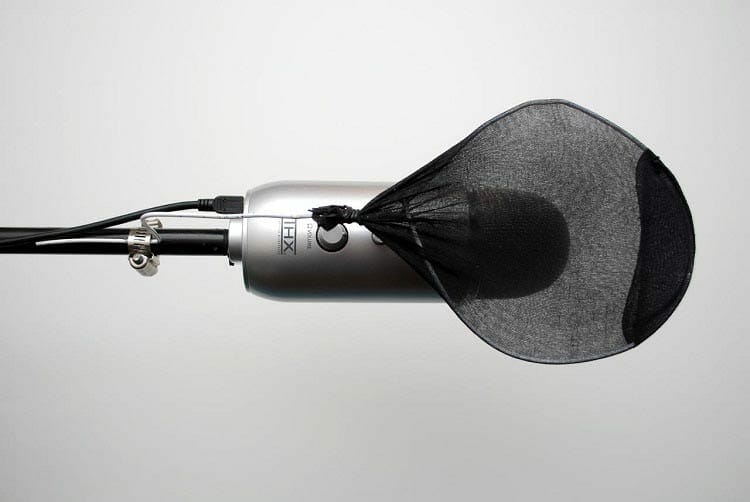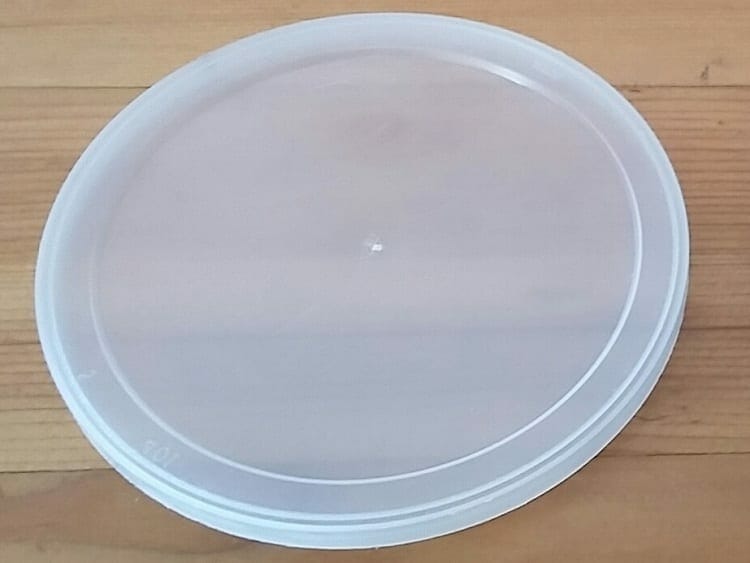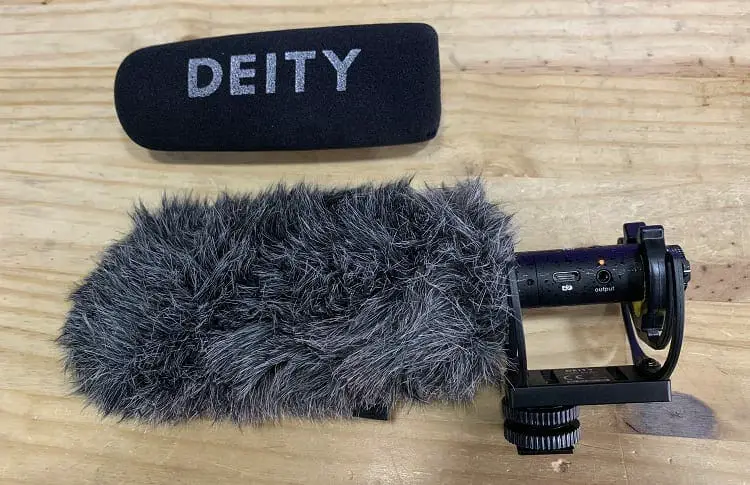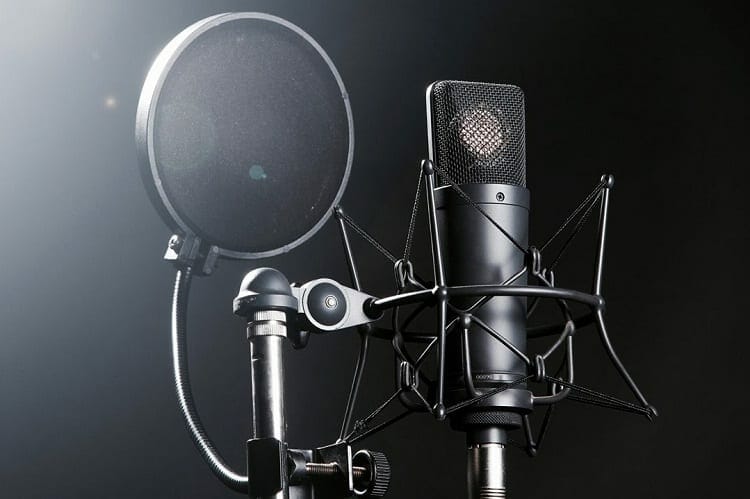How To Make A Pop Filter
When you're wanting to create the highest quality podcast possible, y'all need to cut out all unwanted racket.
That includes those annoying popping sounds that come off your microphone. The all-time way to deal with that trouble is to use a pop filter over your mic.
What is a Pop Filter and How Does information technology Role?
Contrary to popular belief, a pop filter isn't a tool devised to cutting downwards noises close to the microphone. Merely said, a popular filter is a mask that sits between your lips and your microphone while y'all're recording.
These devices don't filter out background noises. Instead, information technology reduces explosive sounds to a great extent and removes about of the popping noises that are generated while yous talk or produce sounds. Primarily, this is associated with the noises caused when people talk or laugh near the microphone.
The function of a pop filter is to mitigate air pressure. In the process, it prevents noises that come along during speech communication. A popular filter works equally a barrier, securing the microphone from saliva.
But why get out and purchase 1 when you can brand one?
A Glaze Hanger Popular Filter

- Have a wire coat hanger and bend it a circle. Then pull the circle apart so that it forms more of a square shape.
- Pull the apartment sides of the shape to make it more of a circular shape.
- Notice a pair of old pantyhose and stretch them over the glaze hanger circumvolve. The extra slack should be gathered effectually the hook of the hanger. Pull the pantyhose equally tight as possible.
- You have at present created a pop filter. Position it directly in front of your microphone (well-nigh an inch abroad). Be sure that the filter does not really touch the microphone.
How to secure the pop filter in place:
- Straighten out the claw of the wire hanger and bend information technology into a broad curve. Secure the end of the wire to the microphone stand up with tape.
- Attach the end of the wire to the mic stand with a clamp holder
- Get a second microphone stand up and attach the pop filter to it. And so position this filter every bit needed.
- Conform the filter position to arrange the type of mic. Some of them take the sound from the pinnacle while others do so from the side.
An Embroidery Hoop Filter
- Obtain an embroidery hoop filter. It may be made from plastic or metal. To match the size of commercial pop filters, you lot volition want the embroidery hood to be well-nigh six inches in diameter. However, larger hoops will work fine.
- Stretch embroidery nylon across the hoop. The hoop will have some sort of latch organization that allows you to stretch out the nylon and secure it in place. They will have inner and outer hoop. Once you have opened the latch stretch the nylon over the inner hoop. Then put the inner hoop back inside the outer hoop and resecure the latch.
Equally an alternative to embroidery nylon, y'all can apply screen door cloth. This is thicker than nylon and will, as a effect, provide a better filter functioning than thinner material.
You tin can choice up screen door mesh cloth at your local hardware store. However, if you have to buy a whole roll, you may just detect it cheaper to actually buy a pop filter!
Coffee Can Lid Filter

- Remove the plastic chapeau from a large can of coffee or similar object. Any plastic lid that is at least 6 inches in diameter. The stiffer the lid is the ameliorate it will work as a pop filter.
- Cutting out the middle of the lid so that but the rim is remaining. A arts and crafts knife is the all-time tool to do this. The cutout portion of the lid can exist discarded.
- Stretch either pantyhose or door screen mesh over the plastic rim. Pantyhose material will be easier to secure with tape or condom bands subsequently pulling it tight. Screen mesh will be a little trickier to secure merely volition give a better pop resisting performance. Yous volition need to use binder clips or have to secure the mesh to the rim.
- Secure your pop filter in place with the use of tapes or clamps.
Make a Pop Filter Using a Sock
You lot can brand a pop filter out of a sock. This is an cheap option, given that you likely already have these items in your home.
For the microphone to grab your vox, you'll demand to talk louder if you use a thick sock. I of the advantages of utilizing a sock is that information technology'south easy to fix with a microphone. Finding the proper sort of sock is the most challenging attribute. If you determine to use one you already own, make sure to launder it before using it. Avoid using a textile softener since information technology might cause pilling and the cloth to run over your microphone.
Make sure to use a thin sock so that your voice doesn't get drowned out. For the all-time results, yous should use sparse, waterproof socks. If you plan to speak loudly, you can go for thicker socks that are meant for snowboarding and skiing.
In one case y'all have the right sock, open up the end and slide information technology over the microphone. Then, pull the sock downward softly. The section meant for the toes must fully comprehend the microphone. Yous may cutting and trim the sock if y'all put on a longer sock. If yous make up one's mind to cut information technology, make sure to trim it from higher up the ankle. This largely depends on its size, so y'all need to decide accordingly.
When using a sock, y'all can use zip ties to secure the popular filter to the microphone. This would prevent any extra fabric from sliding effectually on the microphone. All you need to practise is wrap a naught necktie around the microphone's base. Brand certain to accept a scissors or a knife nearby to remove the zilch tie'due south tail.
Pop Filter / Microphone Q & A
How will a pop filter make me sound better?
When y'all speak into a mic without a pop filter you will ofttimes produce a popping sound on harsh consonants.
This is particularly the case when you pronounce the letters 'P', 'B', 'S' and 'Ch'. A pop filter volition allow yous to say these letters without that annoying popping audio.
A pop filter volition besides prevent saliva or other moisture inadvertently getting onto the microphone which could cause damage.
What is a microphone windscreen and what does it do?

A windscreen is a device that is used in outdoor recordings to reduce the issue of air current and particulate affair that may strike the diaphragm of the microphone.
They normally consist of a thick layer of cream that is designed to fit over the microphone capsule. A windscreen is able to remove both high and low-frequency responses.
They should non be used equally a substitute for popular filters and are only needed if yous will exist recording outdoors.
How should I care for my microphone?
At that place are a few tips that will help yous to best care for your microphone?
- Condenser microphones have extremely thin diaphragms and very high tolerances. They need to be protected from abuse and stupor. A condenser mic should always be mounted on a stand every bit opposed to being handheld. They should merely be used to alive in controlled situations.
- Be sure not to drop a condenser mic or knock over a mic stand or you could permanently damage the diaphragm.
- It is all-time to employ a soft mountain (as opposed to a shock mount) for a condenser microphone. This suspends the mic in a plastic web, assuasive the mount to blot vibrations or physical shock. Hard mounts do non provide this shock-arresting ability.
- Never employ condenser microphones of there is a change of water damage. This obviously includes rain but may also happen if you spill your coffee all over your desk-bound!
- Avoid high humidity situations such due south seaside climates that do not take air conditioning. The operating temperature for most conders is between 55 and 95 degrees Fahrenheit. If your mic starts to produce a crackling sound due to humidity, place information technology well-nigh the heat of a light seedling for about xxx minutes.
Should I get a pop filter or a windscreen for my microphone?

When you record up close you will need a pop filter in gild to end unwanted popping sounds.
If permit unchecked these plosives can interfere with the proper operation of the preamp, compressor, and recorder of the microphone.
A popular filter will become rid of these potential issues before they get to the microphone.
Pop filters also protect the mic from saliva. So, if you re using your mic in your office at your desk or in any other indoor setting, you will definitely need a pop filter.
A windscreen is designed for outdoor use. They are either made of thick foam or bogus fur. They will protect your microphone from plosives that may come upon it in an outdoor environment.
However, a windscreen will naturally impede the audio pickup to a caste. As a result, windscreens should exist used sparingly s needed.
In contrast, the popular filter needs to be used at all times when recording indoors. Yous should only invest in a windscreen, though, if you will be recording outdoors.
What is the best manner to make clean and store a microphone?
A microphone should always be kept in its case when not in use. Practise not leave it sitting on its stand or it volition be susceptible to dust and droppings.
If this gets onto the diaphragm this may cause damage over time. You should wipe the metal outside of your microphone down with a dry out or slightly damp cloth in guild to remove grit, dirt or fingerprints.
If you feel that the mic needs farther cleaning you can spray a household cleaner such as Fantastik or Formula 409 onto a rag and wipe it onto the metal outside.
Exercise not, still, go this anywhere near the diaphragm or sheathing. Do not open up upward the microphone in order to make clean the insides of it.
If you lot notice the performance of your mic is deteriorating, you should take it to a professional service center rather than attempting to open information technology up and do the repair yourself.
What are some tips for speaking into a microphone?
Point the mic at your mouth at a distance of near two hand-widths. Rather than speaking into the mic, speak beyond information technology.
If yous have to adjust the mike, exercise so without touching the capsule. Earlier you first recording, become familiar with the controls. Know precisely where the on/off, mute and volume buttons.
Practise a sound check before yous starting time recording. Get another person to evaluate the sound quality for y'all.
Your body's posture matters when it comes to speaking clearly into the microphone. Be certain to stand or sit straight while using a microphone. If you slouch, your rib cage will get into your abdomen, resulting in sluggish voice communication.
When you lot're standing, go far a comfy position where you tin can speak over the microphone but not into it directly. You may feel sound discrepancies if you're constantly moving as yous speak.
Conclusion
In this article, nosotros have presented you with 3 uncomplicated ways to make your own DIY pop filter.
Nosotros've as well provided plenty of advice and tips to assistance you to get the most out of your microphone recording. You're now all set to share your brilliance with the world!
How To Make A Pop Filter,
Source: https://thestudiogenie.com/diy-pop-filter/
Posted by: morristhoures.blogspot.com


0 Response to "How To Make A Pop Filter"
Post a Comment